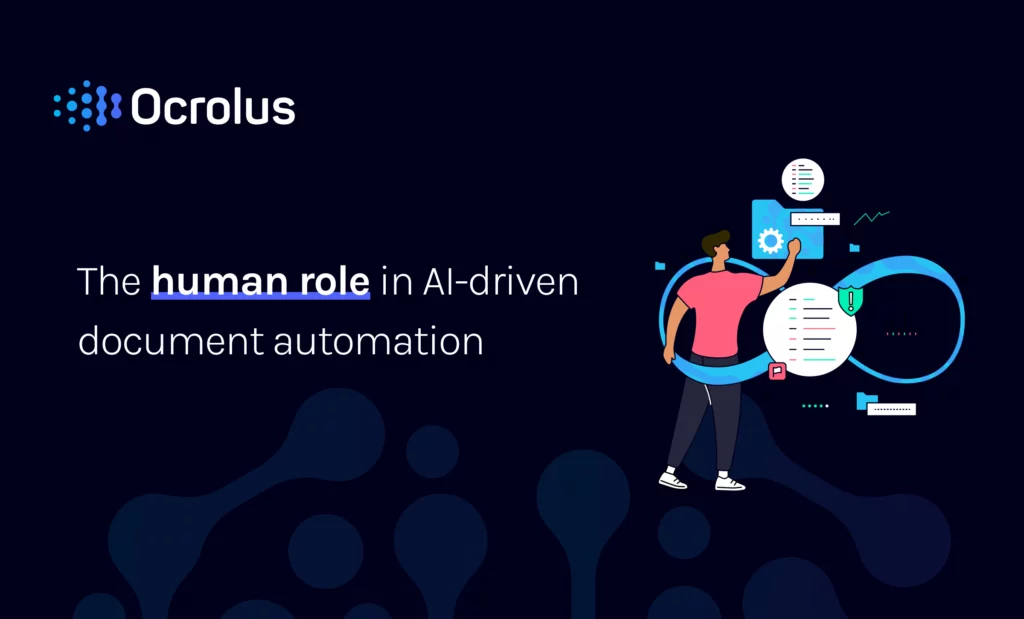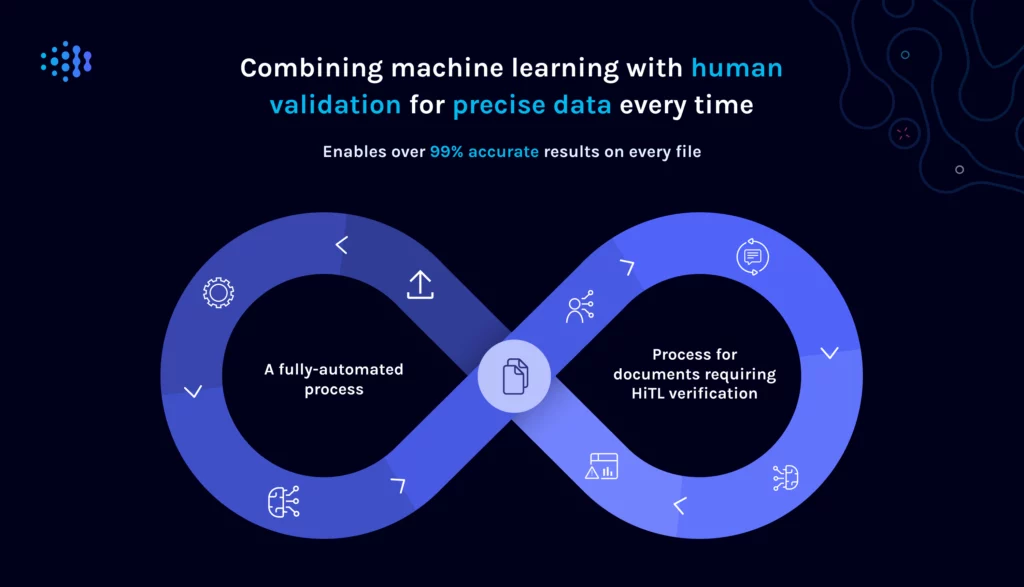This website uses cookies so that we can provide you with the best user experience possible. Cookie information is stored in your browser and performs functions such as recognising you when you return to our website and helping our team to understand which sections of the website you find most interesting and useful.
The human role in AI-driven document automation

At the core of digital document automation technology lies artificial intelligence (AI) and machine learning (ML). The accuracy and efficacy of this technology relies entirely on high-quality data – namely labeled training data – prepared by humans. But the role of humans in this process doesn’t end there.
AI is not a standalone tool. Rather, it is a symbiotic relationship between human expertise and machine intelligence. This synergy allows for the development of sophisticated algorithms that can analyze, extract, and process vast amounts of data with remarkable accuracy and efficiency. Notably, the impressive “GPT” models released by OpenAI have been trained using “Reinforcement Learning with Human Feedback” (aka “Human in the Loop”) to result in more useful and aligned output.
As a result, AI-powered document automation systems have become essential in various industries, especially the finance industry, revolutionizing how businesses handle their document-centric processes and improving overall productivity and accuracy. The interplay between human input and AI capabilities is a key factor in unlocking the full potential of AI document automation technology.
To learn more about the human role in AI-driven document automation, we’ll answer three important questions:
- What is the role of humans with AI?
- What is human in the loop in AI?
- Why is human in the loop important in AI?
What is the role of humans with AI?
The limitations of AI stem from its reliance on training data. No matter how powerful the technology, ultimately an AI model can only be as good as the data on which it was trained. Pairing humans with AI is an indispensable part of the workflow, as humans are responsible for preparing meticulously labeled and curated training data that enables AI to recognize patterns and make accurate decisions.
Human expertise is crucial in defining the parameters and capabilities of AI models, and humans are also involved in fine-tuning the model based on its performance and making necessary adjustments to tailor the output for its intended use case. The continuous loop of human intervention with AI makes it more robust and effective. Combining humans with AI in document processing results in a more comprehensive and accurate approach.
While AI can process large volumes of data quickly, humans can add critical thinking, creativity, and context for complex decision-making. Humans also provide oversight and quality control to ensure accurate and reliable results from AI. By utilizing humans with AI, businesses can achieve a more efficient and effective document workflow automation process, benefiting from the complementary abilities of humans and AI working in tandem.
What is human in the loop in AI?
Human-in-the-loop (HiTL) automation combines the best of AI with the review of humans to create increasingly accurate and effective processes. In HiTL processes, humans play an active role in the training, validation and refinement of AI models or algorithms.
The end-goal of HiTL is to achieve what neither a human being nor a machine can do on their own. It recognizes that while AI has advanced capabilities, there are still tasks or challenges that require human intervention – and together they can thrive.
In the context of document processing AI, HiTL is especially important. When a machine encounters a problem or cannot complete a task on its own, humans step in to teach the AI. For example, in training an AI model for digital document extraction, humans provide labeled training data to train the model so that it is able to recognize similar documents or figures in the future.
But, the model may encounter challenges with variations in document formats, handwriting or other complexities. In such cases, human intervention is necessary to validate and refine the model’s results.
HiTL creates a continuous feedback process, where human expertise complements the capabilities of AI machines. Humans can provide contextual understanding, domain expertise and complex decision-making that machines may lack. They can also correct and fine-tune AI-generated results to ensure accuracy and reliability. This iterative process of human intervention and model refinement improves the performance and capabilities of the AI system over time.
Why is human in the loop important in AI?
In today’s rapidly changing fintech landscape, AI has shifted from being just a competitive advantage to becoming a necessity. The ability of AI to process and analyze large amounts of data has transformed how businesses operate, enabling them to make data-driven decisions and achieve unprecedented levels of efficiency.
However, a common challenge faced by AI and machine learning models is the time and resources required to achieve high levels of accuracy. These models need extensive training data like mentioned before, and the time to learn from it, gradually improving decision-making capabilities. This can be a time-consuming process, especially when dealing with complex tasks or limited training data.
This is where human supervision plays a crucial role. The human-in-the-loop approach involves incorporating human intelligence into the training and validation process of AI models. Humans can provide valuable insights, context, and domain expertise that go beyond the training data, helping the model make more accurate decisions.
Human supervision can also help AI models adapt to real-world scenarios that involve uncertainties and complexities. By providing ongoing feedback and guidance, humans can help the model learn from their expertise and experience, making it more adaptable and responsive to dynamic environments.
HiTL can also refer to having a certain degree of human supervision in fields where errors can be costly. For example, in the finance industry, mistakes can have severe consequences. By utilizing humans in conjunction with AI, errors can be minimized, and the overall solution can learn and improve its results faster, ultimately saving time and money.
From a cost-saving perspective, incorporating human supervision in the AI training process can be highly beneficial. It accelerates the learning curve of the model, leading to faster and more accurate results. This can result in substantial cost savings, as the model can achieve the desired level of accuracy in a shorter time frame.
Ocrolus’ Human in the Loop (HiTL) AI-Driven Solution
Ocrolus is pioneering human in the loop AI-driven solutions for financial institutions, revolutionizing the way lenders approach data verification. By combining the power of AI and humans, Ocrolus enables lenders to achieve reliable and precise outcomes, ensuring data integrity and bottom line savings.
At the heart of Ocrolus’ innovative approach is our proprietary AI technology that leverages machine learning algorithms to extract and analyze data from a wide range of documents with remarkable precision. As an example, our core document classification model is able to accurately classify over 250 distinct document types commonly used in mortgage underwriting.
Classifications with imperfect confidence are routed to Ocrolus data classification and verification specialists for data labeling and quality control. This data is then utilized in a feedback loop, which constantly trains our models to enhance their intelligence and comprehensiveness, thereby minimizing the necessity for human assessment in future scenarios.
This unique human-in-the-loop approach to intelligent document processing automation enables Ocrolus to process every document with over 99% accuracy.

The human role in AI-driven document automation is essential for achieving accuracy and maximizing the potential of AI technology. While AI has seemingly endless advanced capabilities, it still relies on humans to prepare training data, define parameters, fine-tune models, provide critical thinking, creativity, and context and ensure oversight and quality control.
Human supervision is particularly important in complex tasks, instances of limited training data, real-world scenarios and fields where errors can be costly, such as the finance industry. Incorporating human supervision in the AI training process can lead to faster and more accurate results, resulting in substantial cost savings.
Human-in-the-loop processes recognize the complementary strengths of humans and machines to create a continuous feedback loop for refining AI models and improve their performance over time. The synergy between human input and AI capabilities is crucial in unlocking the full potential of AI-driven document automation, revolutionizing industries and improving overall productivity and accuracy.
Book your demo to discover how Ocrolus’ human in the loop AI-driven document automation solution can improve efficiency and accuracy in your lending processes.





